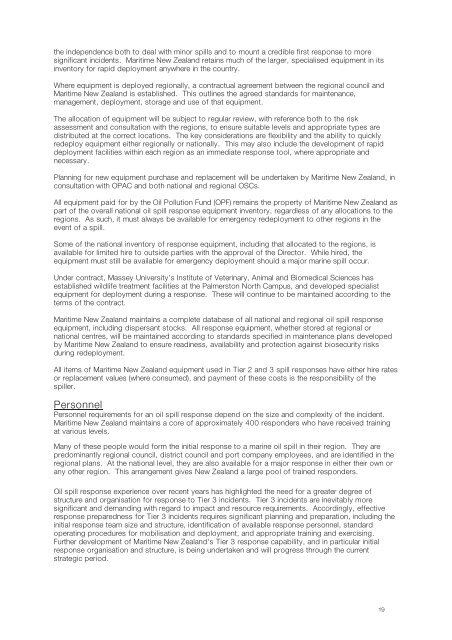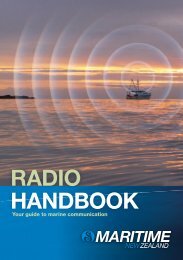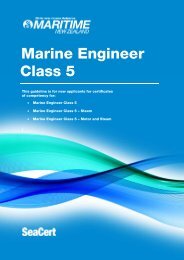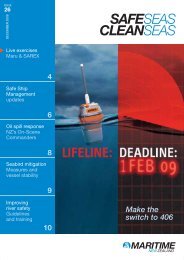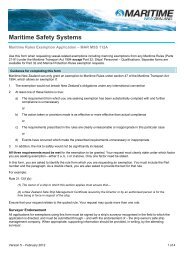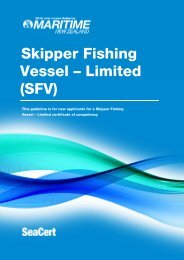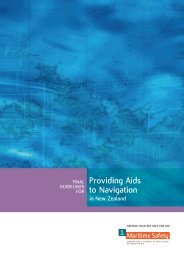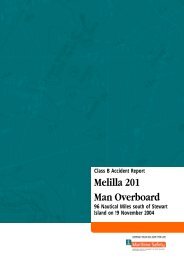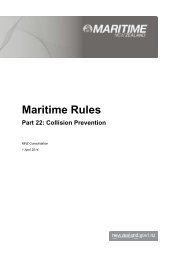New Zealand oil spill response strategy - Maritime New Zealand
New Zealand oil spill response strategy - Maritime New Zealand
New Zealand oil spill response strategy - Maritime New Zealand
You also want an ePaper? Increase the reach of your titles
YUMPU automatically turns print PDFs into web optimized ePapers that Google loves.
the independence both to deal with minor <strong>spill</strong>s and to mount a credible first <strong>response</strong> to more<br />
significant incidents. <strong>Maritime</strong> <strong>New</strong> <strong>Zealand</strong> retains much of the larger, specialised equipment in its<br />
inventory for rapid deployment anywhere in the country.<br />
Where equipment is deployed regionally, a contractual agreement between the regional council and<br />
<strong>Maritime</strong> <strong>New</strong> <strong>Zealand</strong> is established. This outlines the agreed standards for maintenance,<br />
management, deployment, storage and use of that equipment.<br />
The allocation of equipment will be subject to regular review, with reference both to the risk<br />
assessment and consultation with the regions, to ensure suitable levels and appropriate types are<br />
distributed at the correct locations. The key considerations are flexibility and the ability to quickly<br />
redeploy equipment either regionally or nationally. This may also include the development of rapid<br />
deployment facilities within each region as an immediate <strong>response</strong> tool, where appropriate and<br />
necessary.<br />
Planning for new equipment purchase and replacement will be undertaken by <strong>Maritime</strong> <strong>New</strong> <strong>Zealand</strong>, in<br />
consultation with OPAC and both national and regional OSCs.<br />
All equipment paid for by the Oil Pollution Fund (OPF) remains the property of <strong>Maritime</strong> <strong>New</strong> <strong>Zealand</strong> as<br />
part of the overall national <strong>oil</strong> <strong>spill</strong> <strong>response</strong> equipment inventory, regardless of any allocations to the<br />
regions. As such, it must always be available for emergency redeployment to other regions in the<br />
event of a <strong>spill</strong>.<br />
Some of the national inventory of <strong>response</strong> equipment, including that allocated to the regions, is<br />
available for limited hire to outside parties with the approval of the Director. While hired, the<br />
equipment must still be available for emergency deployment should a major marine <strong>spill</strong> occur.<br />
Under contract, Massey University’s Institute of Veterinary, Animal and Biomedical Sciences has<br />
established wildlife treatment facilities at the Palmerston North Campus, and developed specialist<br />
equipment for deployment during a <strong>response</strong>. These will continue to be maintained according to the<br />
terms of the contract.<br />
<strong>Maritime</strong> <strong>New</strong> <strong>Zealand</strong> maintains a complete database of all national and regional <strong>oil</strong> <strong>spill</strong> <strong>response</strong><br />
equipment, including dispersant stocks. All <strong>response</strong> equipment, whether stored at regional or<br />
national centres, will be maintained according to standards specified in maintenance plans developed<br />
by <strong>Maritime</strong> <strong>New</strong> <strong>Zealand</strong> to ensure readiness, availability and protection against biosecurity risks<br />
during redeployment.<br />
All items of <strong>Maritime</strong> <strong>New</strong> <strong>Zealand</strong> equipment used in Tier 2 and 3 <strong>spill</strong> <strong>response</strong>s have either hire rates<br />
or replacement values (where consumed), and payment of these costs is the responsibility of the<br />
<strong>spill</strong>er.<br />
Personnel<br />
Personnel requirements for an <strong>oil</strong> <strong>spill</strong> <strong>response</strong> depend on the size and complexity of the incident.<br />
<strong>Maritime</strong> <strong>New</strong> <strong>Zealand</strong> maintains a core of approximately 400 responders who have received training<br />
at various levels.<br />
Many of these people would form the initial <strong>response</strong> to a marine <strong>oil</strong> <strong>spill</strong> in their region. They are<br />
predominantly regional council, district council and port company employees, and are identified in the<br />
regional plans. At the national level, they are also available for a major <strong>response</strong> in either their own or<br />
any other region. This arrangement gives <strong>New</strong> <strong>Zealand</strong> a large pool of trained responders.<br />
Oil <strong>spill</strong> <strong>response</strong> experience over recent years has highlighted the need for a greater degree of<br />
structure and organisation for <strong>response</strong> to Tier 3 incidents. Tier 3 incidents are inevitably more<br />
significant and demanding with regard to impact and resource requirements. Accordingly, effective<br />
<strong>response</strong> preparedness for Tier 3 incidents requires significant planning and preparation, including the<br />
initial <strong>response</strong> team size and structure, identification of available <strong>response</strong> personnel, standard<br />
operating procedures for mobilisation and deployment, and appropriate training and exercising.<br />
Further development of <strong>Maritime</strong> <strong>New</strong> <strong>Zealand</strong>'s Tier 3 <strong>response</strong> capability, and in particular initial<br />
<strong>response</strong> organisation and structure, is being undertaken and will progress through the current<br />
strategic period.<br />
19


